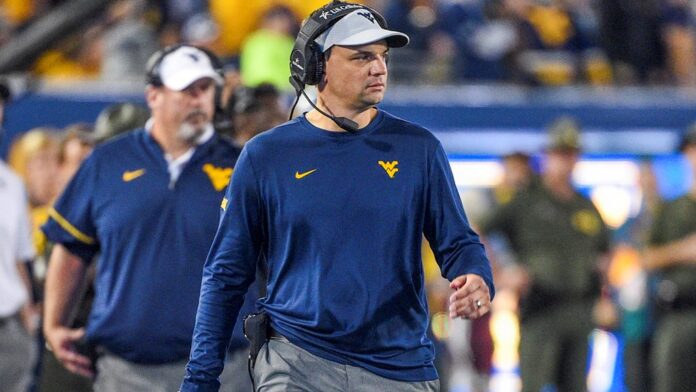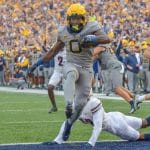
(Photo Courtesy of wvusports.com)
Contrary to popular belief, the West Virginia Mountaineers are exactly where they should be. Does anyone want to be 4-3? No. I understand the goal is to win. However, just because these kids put on the Old Gold and Blue, doesn’t mean they are magically a top talent.
2019 was no doubt a start of a complete rebuild. I’m not sure if people were blind to it or not, but there wasn’t much left to work with. WVU squeaked out everything they could in the 8 years with Dana Holgorsen at the helm. Is Dana Holgorsen better suited as an offensive coordinator? Probably. What Holgorsen did best was get the most out of his offense, no matter who was available. He won some games WVU wasn’t supposed to win. He also lost games they had no business losing. Neal Brown only has one loss in which his team was favored.
What was the most frustrating part of Holgorsen’s tenure? Clock management and field position. Time and time again, Holgorsen mismanaged clock that either didn’t save the Mountaineers time, or gave the opponent too much time knowing very well the suspect defense he had behind him. He used his offense to try and mask the defense. Love the gamble, but sometimes complimentary management decisions would have been the smarter move. Head coaches are paid for their game management. Holgorsen wasn’t ready for ALL of that responsibility.
New coach Neal Brown brings a completely different set of skills to Morgantown and it’s time to appreciate and understand that. Week after week I see complaints of Brown’s play calling, his decision making, his non aggression. News flash, Will Grier isn’t the quarterback. David Sills, Kevin White, Stedman Bailey, nor Tavon Austin are lined up wide. There are ZERO mismatches to take advantage of offensively.
Coaches call every play to score a touchdown. Properly executed, each play in theory should score. The only way play calling should be criticized is when the same negative result is clear; over and over and over. I have yet to see Neal Brown stick with something that clearly isn’t working (I know you all will say running the ball on third down). Brown is showing just how a head coach should operate with inferior talent. Coaching to their strengths and putting the team in the best position to win.
Some of you are now yelling “stop running on third down”, so let’s take a look at some statistics that might show what I mean. Outside of WVU, all other schools have had 171 third down PASS plays of 10 or more yards. 30 of these have been converted. That’s a tick over 17%. West Virginia has thrown on 20 of 31 third downs of more than 10 yards. They’ve converted 6 of these (30%), tops in the Big 12. The league average of pass plays on these downs is 66%. West Virginia throws on 65% of these downs. Now the next obvious argument is what? Throw the ball more right? Wrong.
If you’ve ever listened to a Neal Brown answer about a game situation you’ll hear a word continually pop up, data. Brown is HUGE into the analytics department of decision making. Right or wrong, this is the methodology he takes for a majority of his big decisions. So you may be thinking “WVU hits at 30% throwing the ball on these plays, why not throw it another 10% of the time and convert more?”
Answer: Law of Statistics. I may have just made that term up but it’s statistically true. All stats will filter to their true mean (average) at some point. Therefore it is reasonable to assume the 30% success rate throwing the ball on these downs will eventually trickle towards 17%. Don’t forget, WVU’s last 5 opponents have the bottom 5 defenses in the Big 12; the next 3 are ranked 3rd-5th. Continuing to force throws on 3rd and very long will result in opponents gaining favorable field position along with more possessions to do more damage.
Aside from the statistics of these downs, let’s remember this team has no go to player to get tough yards. Jarret Doege is an experienced, serviceable quarterback that makes quick and often correct decisions. The drawback is the inaccuracy. With a defense as good as the one the Mountaineers have and an offense without an explosive threat, why chance a turnover on a throwaway down that puts the TEAM behind early? While I believe the odds are slim with Doege at quarterback, probably less than 7%, there’s just no need to take the chance.
Take your points, flip the field when necessary in the first half. If you’re trailing/close, keep the game as close to a one possession game for as long as possible. This is precisely why Neal Brown dominates the field position factor, and plays perfect complimentary football that puts his TEAM in the best position to win. You may notice I continue to put TEAM in all caps. The key difference in the upgrade of coaching from Dana Holgorsen to Neal Brown is the TEAM factor. Brown uses his offense and defense in a tandem to play the game. Holgorsen used his offense to outscore the opponent.
Finally, to wrap this entire rant together, let’s dive into what a true, on track rebuild looks like in 4 years. The first year of a rebuild is expected to be miserable. Somewhere within this year you build your foundation. The second year of a rebuild should show improvement, competitive within the conference. Somewhere around a .500 record in conference play. The third year should show growth, maturity. Winning close games and winning on the road, defending home, and getting the statement win. The final year of the rebuild is maximizing the realistic potential. If this is a 10 win, New Year’s Six team, go get it. If it’s one that can get to the CFP, go get that.
I’d like to use Iowa State as an example. Fresh off three straight years of 9 or more losses, Iowa State needed a change heading into the 2016 season. Head coach Matt Campbell was hired after back to back 9 win seasons at Toledo. In Campbell’s first season, Iowa State was 2-7 in the Big 12. This is your year one miserable. The second year was an improvement to competitive and showed at a 5-4 record in conference. The third step for Campbell was a two year process. We’re looking for winning close games, winning on the road, and getting the statement win. In 2018 and 2019 Iowa State only lost 3 games at home. In each season, they won 2 of their 4-5 conference road games. This year in what I would call the transition to their final year of the rebuild, Iowa State has won all but one of their one possession games. They also found their statement win against Oklahoma. No this isn’t a CFP team but it is certainly capable of a New Year’s Six bowl which will be maximizing their realistic potential.
Let’s take a look at WVU’s trajectory. Year one for Neal Brown, 3-6 in conference, miserable. Year two thus far, 3-3. Understandably, WVU could lose the rest of their games and be in the same boat they were last season. However, two wins out of the remaining three games isn’t unthinkable. WVU has a 4-0 record at home this season and undoubtedly plays better at Milan Puskar Stadium. With two of the final three games at home, WVU could end up 5-4 in conference showing the improvement from year one to year two. The struggle this season has been closing out one possession games. All three losses have been a one possession game late in the 4th quarter. Finishing these games next season puts WVU in the top 3 of the Big 12, ready to capitalize on their full potential in the 2022 season.
I want to win every game as much as anyone, trust me. But let’s all relax and take the gains and punches in stride. This team is building its foundation on defense and putting the pieces where they can on offense. It has the right guy at the helm, this is coming from someone that demanded Tony Gibson get a shot at the head spot. The Mountaineers are doing exactly what they should be to get back to the 9-10 win team we were early in the millennium.






